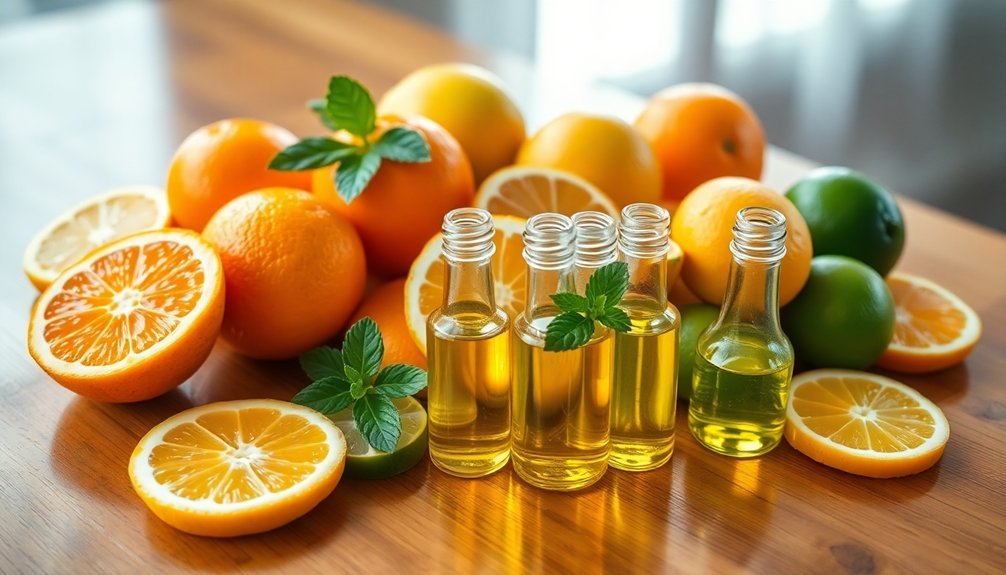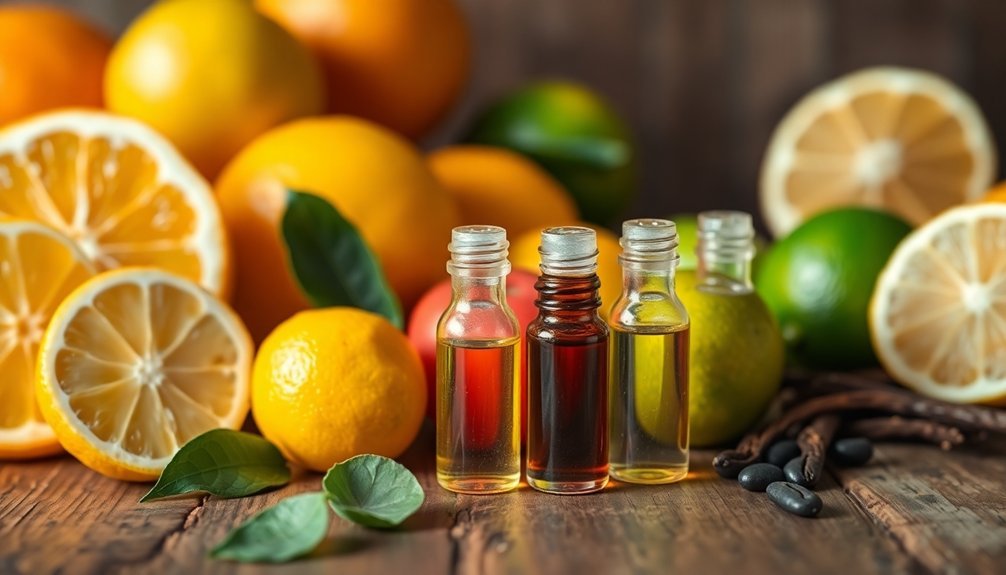When creating citrus perfumes, you'll find bergamot and lemon work beautifully as bright top notes, while orange and grapefruit provide balanced sweetness and tang in the middle. You can enhance longevity by layering these oils with vanilla or woody base notes like cedarwood. Try pairing mandarin with lemon to soften sharp edges, or add neroli for a floral dimension. These combinations just scratch the surface of citrus perfumery's aromatic possibilities.
The Science Behind Citrus Oil Harmony

When you explore the molecular world of citrus oils, you'll find a fascinating interplay of chemical compounds that create their signature fragrances. At the heart of these oils, limonene and citral molecules work together to produce bright, uplifting scents that captivate your senses. Like our Citrus Harmony fragrance, these oils combine refreshing top notes with deeper, woody undertones.
Understanding how these molecules interact is key to creating harmonious perfume blends. Each citrus oil contains a unique mix of compounds that evaporate at different rates, forming distinct top, middle, and base notes.
When you inhale these fragrances, the molecules bind to your olfactory receptors, triggering specific responses in your brain. This molecular dance creates synergistic effects when oils are blended – bergamot enhances other scents without overwhelming them, while combining bright citrus with earthy notes produces complex, balanced profiles.
Essential Citrus Notes for Perfume Making
When you're crafting citrus-based perfumes, you'll want to start with bright combinations like bergamot and lemon for an uplifting top note that immediately captures attention.
Your core citrus building blocks should include essential oils like orange and grapefruit, which serve as the foundation for complex fragrance compositions. These citrus notes are known for their ability to blend harmoniously with other ingredients.
Finding the right balance between sweet orange and tart lime notes lets you create dynamic scent profiles that evolve beautifully on the skin.
Bright Top Note Combinations
Since citrus oils play a vital role in modern perfumery, understanding their bright top note combinations is essential for creating enchanting fragrances.
You'll find that pairing complementary citrus notes creates complex and sophisticated scents that captivate the senses.
- Lemon and bergamot work together to deliver a crisp, clean aroma where bergamot's complexity balances lemon's sharpness.
- Orange and grapefruit create a perfect harmony between sweetness and tang, ideal if you're seeking a less sugary citrus profile.
- Bergamot and lemon with green notes offer versatility, while adding neroli introduces a pure, floral dimension.
When combining these oils, remember that quality matters, especially with neroli, which can be harsh if not properly sourced.
These combinations provide an uplifting and refreshing experience that enhances both mood and energy levels.
You'll achieve the best results by carefully balancing these bright notes to create revitalizing, sophisticated fragrances.
Core Citrus Building Blocks
Mastering the core citrus building blocks forms the foundation of successful perfume creation. You'll find that lemon, orange, bergamot, grapefruit, and lemongrass essential oils each bring unique characteristics to your fragrances. These oils excel as top notes, adding brightness and importance while complementing deeper base notes.
| Oil Type | Key Characteristics | Best Pairings |
|---|---|---|
| Lemon | Bright, clean, invigorating | Benzoin, Patchouli |
| Orange | Sweet, joyful, essential | Cedarwood, Rose |
| Bergamot | Fruity, floral-citrus | Jasmine, Sandalwood |
When working with citrus oils, remember they're phototoxic and require proper dilution. For the best results, choose organic varieties and filter your final creation through a coffee filter to remove sediment. You'll discover that citrus oils not only provide uplifting aromas but also offer therapeutic benefits like stress relief and mood enhancement.
Balancing Sweet With Tart
As you craft citrus-based perfumes, balancing sweet and tart notes becomes essential for creating sophisticated fragrances.
You'll find that bergamot's unique sweet-bitter profile works beautifully with orange's warmth, while lemon's brightness can complement grapefruit's tang. For less sweetness, try grapefruit as your primary note.
- Combine mandarin with lemon to soften sharp edges while maintaining vibrancy
- Layer citrus with vanilla or woody notes to add depth and warmth
- Mix citrus with florals like jasmine or rose for a rejuvenating twist
When blending, remember that citrus oils typically serve as top notes, setting your fragrance's initial impression.
You'll want to carefully consider phototoxicity levels and dilution ratios, especially when creating perfumes for skin application. The key is harmonizing these bright notes with heart and base notes for a well-rounded scent.
Top Citrus Combinations for Long-Lasting Scents
While citrus scents are known for their bright and energizing qualities, they often fade quickly without proper blending techniques. You'll get the most longevity by layering citrus oils with complementary middle and base notes. Try combining bergamot with lime for depth, or orange with vanilla for a lasting sweetness.
| Citrus Oil | Perfect Partner | Emotional Effect |
|---|---|---|
| Bergamot | Lavender | Calming & Balanced |
| Grapefruit | Rosemary | Energizing & Clear |
| Orange | Vanilla | Comforting & Joyful |
| Lime | Coconut | Uplifting & Fresh |
For maximum staying power, incorporate woody bases like cedarwood or sandalwood. You can also enhance longevity through double infusion techniques or by adding musk. Remember to balance your blend with middle notes like lemongrass or rose to create a well-rounded fragrance that lasts throughout the day.
Balancing Sweet and Tart Citrus Notes

When you're working with citrus oils in perfumery, you'll find that combining sweet notes like orange and mandarin with sharper ones like lemon and grapefruit creates remarkable depth and complexity.
You can layer different citrus intensities by starting with the brightest top notes and gradually introducing mellower citrus elements to build a more sophisticated fragrance profile.
Your best results will come from strategic pairings, such as bergamot with lemon or blood orange with grapefruit, which naturally complement each other while maintaining distinct personalities in the final blend.
Sweet Meets Sharp Notes
Creating a harmonious balance between sweet and sharp citrus notes requires understanding their unique characteristics and interactions. You'll find that combining orange's sweet juiciness with lemon's bright tanginess creates an invigorating blend perfect for daytime wear. This pairing delivers both warmth and crispness while maintaining an energetic profile.
- Orange and lemon form a classic foundation that's both revitalizing and balanced
- Grapefruit and orange create a modern, complex blend suitable for unisex fragrances
- Lime and rosemary offer an awakening combination that promotes mental clarity
When you're working with citrus oils, consider how each note complements the other. The sweet orange tempers lemon's sharpness, while grapefruit adds sophistication to orange's sweetness.
You can further enhance these combinations by adding floral or woody notes for additional depth.
Layering Citrus Intensity Levels
Building on the sweet and sharp combinations, mastering the art of layering citrus intensities takes your perfume creation to new heights.
Start by selecting bright citrus top notes like lemon, orange, or bergamot as your foundation. You'll find bergamot particularly versatile, offering both sweetness and bitterness, while orange provides a juicier, softer profile.
To add depth, layer your chosen top notes with complementary middle notes. You can pair bergamot with lime or grapefruit, or introduce green elements like mint and basil for extra freshness.
Don't forget to anchor your creation with base notes – soft musks, light florals, or woody elements like cedarwood will extend your fragrance's longevity.
For a truly unique scent, try mixing different citrus combinations, such as mandarin with bergamot or lemon with grapefruit.
Complementary Citrus Pairings
Three essential principles guide the art of balancing citrus notes in perfumery: complementary pairing, intensity control, and harmony.
When you're working with citrus oils, you'll find that certain combinations create magic through their contrasting yet complementary nature.
- Orange and vanilla create a perfect balance, where vanilla's warmth softens the citrus tang while enhancing its natural sweetness.
- Lime and coconut offer a tropical blend that combines sharp citrus notes with creamy sweetness, ideal for summer fragrances.
- Grapefruit and rosemary deliver an energizing combination, with rosemary's herbal notes tempering grapefruit's bright acidity.
You can explore endless possibilities by mixing citrus with florals like bergamot and lavender, or adding depth with passion fruit and gardenia.
The key is finding pairings that balance tart and sweet notes while maintaining their individual character.
Creating Depth With Citrus and Base Notes

While citrus oils provide vibrant top notes in perfumery, they truly shine when paired with deeper base notes that anchor and enhance their freshness.
You'll find that musk and vanilla are particularly effective in extending the longevity of citrus scents while adding warmth and depth to the composition.
If you're looking to create a more complex fragrance, consider adding benzoin or Tolu balsam to your citrus blend.
These resinous materials provide a sweet, rich foundation that supports the bright citrus notes without overwhelming them.
For maximum staying power, you can't go wrong with ambrocenide, which acts as an excellent fixative while enhancing the overall citrus character.
These base notes don't just add complexity – they transform fleeting citrus scents into long-lasting, sophisticated fragrances.
Seasonal Citrus Blends for Every Occasion
The art of seasonal citrus blending opens up endless possibilities for creating the perfect fragrance throughout the year.
In summer, you'll find light and rejuvenating combinations of lemon, lime, and grapefruit that keep you energized during hot days. For winter, citrus oils combined with spicy notes like cinnamon and ginger create warming, mood-boosting blends that combat those dark winter days.
- Pair citrus with herbs like basil and rosemary for a sophisticated daytime fragrance
- Combine citrus with florals like jasmine and neroli for a feminine touch
- Add woody notes like cedarwood and sandalwood to extend your fragrance's longevity
Whether you're looking for an invigorating summer scent or a cozy winter blend, citrus oils provide versatile options that work beautifully with complementary notes to match any season.
Breaking Down Popular Citrus Perfume Formulas

Modern perfumery relies heavily on citrus combinations that create distinctive and memorable fragrances.
You'll find that lemon and bergamot work beautifully together, with bergamot softening lemon's sharp edges while maintaining a fresh, crisp profile.
When you're looking for a romantic blend, orange blossom and jasmine create an enchanting duo that's perfect for spring, especially when grounded with musk or amber.
For summer scents, you can't go wrong with grapefruit paired with aquatic notes – it's like capturing an ocean breeze in a bottle.
If you're seeking something more sophisticated, try bergamot with cedarwood, which offers a bright opening that settles into a warm, woody base.
These combinations aren't just random pairings; they're carefully crafted formulas that guarantee both harmony and longevity.
Techniques for Layering Multiple Citrus Oils
Successfully layering multiple citrus oils requires a methodical approach that builds from the ground up.
You'll want to start with a solid base note, allowing it to dry completely before adding complementary middle and top notes at your pulse points.
- Begin with heavier citrus oils like bergamot as your foundation
- Add harmonizing middle notes such as neroli or other citrus blends
- Finish with light, volatile top notes like lemon or lime for immediate impact
Remember to test your combinations on blotter papers first to verify the scents work well together.
You can enhance longevity by using different product formats, like combining body oils with sprays.
Don't overdo it – balance is key, and you'll want to avoid using too many strong scents at once, which can create an overwhelming fragrance.
Frequently Asked Questions
Can Citrus Oils Stain Clothes When Used in Perfumes?
Yes, citrus oils in perfumes can stain your clothes. They're concentrated and contain natural dyes that'll cling to fabric fibers. You'll want to let your perfume dry completely before dressing to avoid stains.
How Often Should Citrus-Based Perfumes Be Reapplied Throughout the Day?
You'll need to reapply citrus-based perfumes every 3-4 hours due to their volatile nature. In hot weather, you might need more frequent reapplication. Consider applying before lunch and early evening for best results.
Are Synthetic Citrus Oils More Stable Than Natural Ones?
Yes, you'll find synthetic citrus oils are more stable than natural ones. They'll maintain their scent longer, won't vary due to environmental factors, and are specifically designed for consistent, long-lasting fragrances in your perfumes.
Which Citrus Oils Are Safe for Sensitive Skin?
You'll find bergamot and sweet orange are safest for sensitive skin. They're gentle when properly diluted. Steam-distilled versions are better than cold-pressed oils, and you should always do a patch test first.
Do Citrus Perfumes Attract Insects in Warm Weather?
You'll find that sweet citrus perfumes can attract insects in warm weather, but more acidic citrus scents like lemon and lime may actually help repel them. It's best to combine them with natural repellents.
In Summary
By experimenting with these citrus oil combinations, you'll discover endless possibilities for creating your signature scent. Remember that successful citrus perfumes balance bright top notes with anchoring base oils for longevity. You're now equipped to mix sweet orange with zesty bergamot, blend tart grapefruit with smooth mandarin, or layer lemon with exotic yuzu. Don't be afraid to try unexpected pairings – that's where the magic happens.
References
- https://essencetics.com/blogs/interesting/the-best-combinations-of-citrus-scented-fragrances-for-soap
- https://www.perfumerflavorist.com/fragrance/ingredients/article/21860606/citrus-oils-in-perfumery-and-cosmetic-products
- https://www.nisarabeauty.com/blogs/blogs/how-to-layer-citrus-perfumes-for-an-energizing-start-to-the-day
- https://www.aupress.ca/app/uploads/OER-202302_Chamberlain_Dubberlboer_2023-Read-Think-Write.pdf
- https://www.aromaweb.com/essentialoils/citrus-essential-oils.php
- https://scentiausa.com/products/citrus-harmony
- https://www.aerowest.com/using-citrus-fragrances-to-increase-productivity-at-work/
- https://nyc.ph/blogs/inspiration/the-chemistry-of-fragrance-how-essential-oils-create-the-perfect-scent
- https://nurturehandmade.com/products/orange-patchouli-fragrance-oil
- https://anthonymarmin.com/the-perfume-blog/citrus-in-perfumery





Leave a Reply